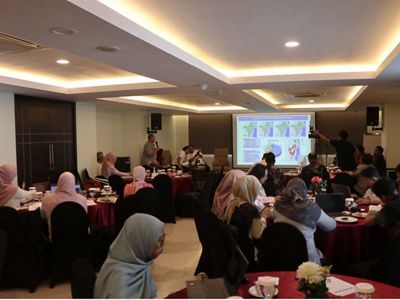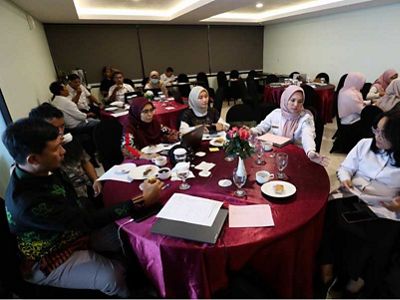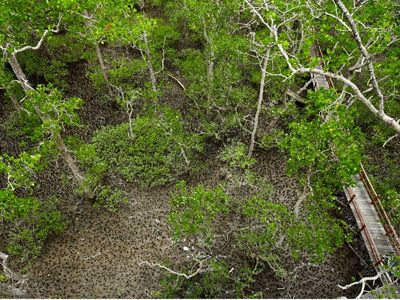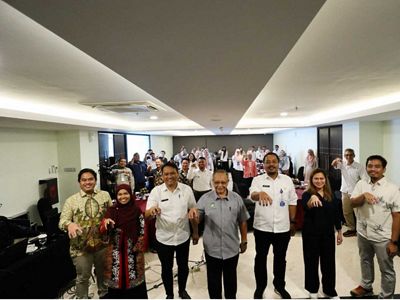East Kalimantan Provincial Government Encourages Sustainable Funding Scheme Through Blue Carbon Ecosystem

Media Contacts
-
Adia Puja Pradana
Communications Specialist Ocean Program YKAN
Yayasan Konservasi Alam Nusantara
Email: adia.pradana@ykan.or.id
The blue carbon ecosystem is crucial to economic progress and natural sustainability. It emerged in a workshop with the theme "Sustainable Funding Schemes and Management of Blue Carbon Ecosystems in East Kalimantan," which was held by the East Kalimantan Provincial Government with the support of the East Kalimantan Regional Council for Climate Change (DDPI) and Yayasan Konservasi Alam Nusantara (YKAN), in Samarinda, March 6, 2024. This workshop involves various stakeholders, including government, society, practitioners, academics, and development partner institutions.
In developing the Green Kaltim Vision approach, the East Kalimantan Provincial Government has initiated the Green Development Compact (GGC) program. Through a collaborative approach involving various parties, GGC has several funding model initiatives spread across East Kalimantan, including the Forest Carbon Partnership Facility Carbon Fund (FCPF-CF).

The successful implementation of FCPF-CF made Indonesia the first country in the Asia Pacific to receive performance-based carbon compensation totaling USD 110 million. This compensation has provided benefits for regional development and village communities. However, PCPF-CF will end in 2024, so it is necessary to anticipate and formulate directions after the end of FCPF-CF funding, including looking at the potential for broader sustainable funding, such as from the blue carbon ecosystem.
FCPF-CF is still focused on reducing deforestation and degradation emissions and increasing carbon stocks in inland forests. For this reason, the role of blue carbon, such as mangroves, seagrasses, and tidal bushes, must be maximized because they are also important in storing carbon.
Blue Carbon Ecosystem Management Policy
Policies for climate change, including those in the maritime sector, are stated as the 6th National Strategy in the 2020-2024 RPJMN through Presidential Decree No. 18/2020, namely building the environment and increasing disaster resilience and climate change. The Coordinating Ministry for Maritime Affairs and Investment assigned the Ministry of Maritime Affairs and Fisheries (KKP) to formulate submission materials and coordinate implementing adaptation and mitigation actions in the marine environment.

Blue Carbon Management is one of four parts of the potential for climate change mitigation in the marine and fisheries sector. "Blue carbon is an important ecosystem in efforts to control climate change, examples of which are mangroves, seagrass, and brackish swamps. "Apart from that, the marine sector is also a new initiative in Indonesia's Nationally Determined Contribution (NDC)," Young Expert Marine and Coastal Ecosystem Manager, Ministry of Maritime Affairs and Fisheries, Fina Ardarini said.
Coastal ecosystems in Indonesia, especially mangroves, seagrass beds, and brackish swamp areas, have the potential for substantial blue carbon reserves, namely as absorbers and natural carbon stores whose capacity exceeds that of mainland tropical forests. "Indonesia has a vibrant natural resource base and blue carbon potential in coastal areas and small islands. "This is supported by the fact that Indonesia covers more than 60% of the world's total Coral Triangle area," said the Head of the Sub-Directorate for Climate Change Resource Support, Ministry of Environment and Forestry, Wawan Gunawan.
Blue Carbon Ecosystem in East Kalimantan
From the 2000s to 2017, the rate of deforestation in East Kalimantan reached 176,400 hectares, caused by the development of oil palm plantations, forest plantations, mining, logging, agriculture, ponds, and others. Apart from that, East Kalimantan also has 14 thousands hotspots that are prone to fire. Peatlands also have the same problem: They have the potential to store emissions and are prone to releasing emissions if burned, so East Kalimantan was ranked third nationally as the most significant contributor to emissions in 2011.
The East Kalimantan government feels it is necessary to take steps in the form of policies to carry out green development in the future. This policy started with the Kaltim Green Declaration in 2010. "Managing the blue carbon ecosystem is important for a sustainable and better future. "Therefore, meetings and discussions like this need to be developed to broaden horizons and policies, especially regarding blue carbon," said Daily Chair of the East Kalimantan Regional Council for Climate Change (DPPI) Daddy Ruhiyat.
The head of the Marine Spatial Management Division, East Kalimantan Province Maritime and Fisheries Service, M. Ali Aripe, stated, "Blue carbon is closely related to the blue economy concept in East Kalimantan, which applies three important pillars, namely ecological, economic, and social. The value of the blue economy in East Kalimantan comes from salt-producing fisheries resources, ecotourism, and other services. The ecological value comes from the potential of mangrove land and seagrass beds. Then, it is illustrated in existing marine space management programs and activities."

"There are five mangrove conservation strategies in East Kalimantan, namely strengthening policy and institutional frameworks, strengthening management and governance, increasing the role of the community, enforcing laws in carrying out mangrove conservation, and encouraging funding mechanisms that support mangrove conservation," Head of the Watershed Management Division and Land Forest Rehabilitation, East Kalimantan Provincial Forestry Service, M. Subiyantoro added.
Sustainable Financing of the Blue Carbon Ecosystem
In practice, the abovementioned efforts can be carried out optimally with a sustainable funding scheme. This ensures that the efforts can continue. One of the efforts made by the government is to form the Environmental Fund Management Agency (BPDLH), which is one of the climate funding strategies and other broader environmental funding.
Environmental funds managed by BPDLH are allocated to programs or activities that can achieve BPDLH goals and targets. These funds can also be allocated for management support, subsidies, grants, guarantees, financing, or loan expenditures.
Specifically, blue carbon has not yet been included in the BPDLH program, but there is room to reduce greenhouse gas emissions. "A total of 13 priority programs are currently being implemented and can be funded by BPDLH. The total funds managed to date are 1,615 billion USD, which includes blue carbon funds sourced from a World Bank grant of 419 million USD for mangrove rehabilitation and management activities," Lia Kartikasari, the head of the Program Fund Distribution Division, BPDLH, said.

Program Director of PT GAIA, Joseph Hutabarat, said, "Apart from traditional funding schemes in the form of grants and loans, there are sustainable funding schemes, namely schemes that include elements of natural capital, social capital, and financial capital." He says many sustainable funding schemes come from donor grants, business partnerships, and philanthropy. Funding like this is widely used to finance conservation actions such as compensation or credits for biodiversity, livelihoods, and community life (livelihood), such as Social Forestry Business Group businesses (KUPS enterprise), and climate change prevention actions (climate actions), such as the carbon market.
YKAN, which fully supports the blue carbon ecosystem management initiative, also appreciated the collaborative commitment of various parties in this event. "An understanding of the various initiatives around coastal ecosystems and blue carbon, as well as existing sustainable funding schemes, are urgently needed to map needs and discuss the suitability of these schemes with ongoing conservation efforts," concluded Coastal Resilience Senior Manager, YKAN, Mariska Nirwan.
Yayasan Konservasi Alam Nusantara (YKAN) is a scientific-based non-profit organization that has been present in Indonesia since 2014. With the mission of protecting lands and waters as life support systems, we provide innovative solutions to realize the harmony of nature and humans through effective natural resource management, prioritizing a non-confrontational approach, and building a network of partnerships with all stakeholders for a sustainable Indonesia. For more information, visit ykan.or.id.

